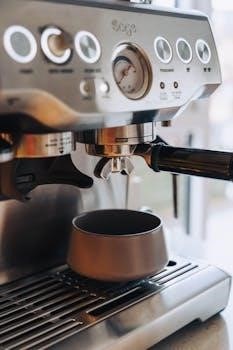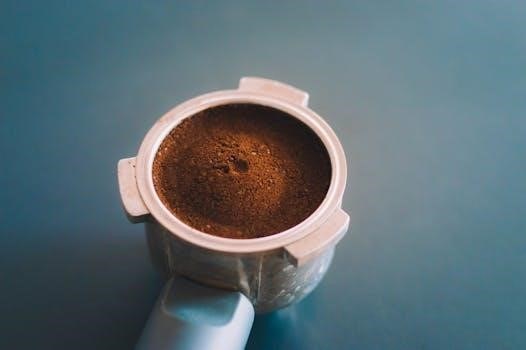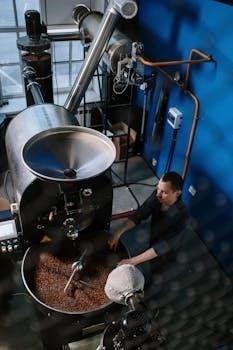Krups Espresso Machine Instructions
This guide provides comprehensive instructions for operating your Krups espresso machine. It covers initial setup, brewing, milk frothing, cleaning, and troubleshooting to ensure optimal performance and longevity. Consult this manual for best results.

Initial Setup and Preparation
Before your first use of the Krups espresso machine, it’s crucial to properly prepare the device. Begin by carefully unpacking all components and removing any protective packaging. Thoroughly inspect the machine for any damage that may have occurred during shipping. Familiarize yourself with the different parts of the machine, including the water reservoir, bean hopper, drip tray, and control panel. Ensure that the machine is placed on a stable, level surface, away from any water sources or heat generating appliances. Refer to your specific model’s user manual for detailed diagrams and component names. It’s also essential to clean all removable parts with warm, soapy water and allow them to dry completely before proceeding. This initial step ensures hygiene and optimal performance, and will help remove any potential manufacturing residues. Check if the machine requires a water filter and install it according to instructions. Following these initial steps will contribute to a smooth and efficient coffee brewing experience. Make sure all parts are correctly assembled before moving to the next step.
Water Reservoir Filling
To ensure your Krups espresso machine functions correctly, proper water reservoir filling is essential. First, locate the water reservoir, which is usually at the back or side of the machine. Remove the reservoir from the machine, and rinse it thoroughly with fresh water before filling. It is recommended to use fresh, filtered water for the best tasting espresso, as tap water might contain minerals that can affect the machine’s performance and coffee flavor. Fill the reservoir to the maximum fill line indicated, which is typically marked on the side of the container. Avoid overfilling, as this can cause leaks and damage to the machine. Once filled, carefully reinsert the reservoir into its designated slot, making sure it is securely in place. Ensure that the reservoir is properly aligned with the machine to avoid any issues during operation. After filling, check for leaks and make sure that the reservoir sits correctly. This step is crucial, as the machine will not operate without sufficient water in the reservoir.
Coffee Bean Hopper Loading
Loading the coffee bean hopper correctly is a crucial step in preparing your espresso. Begin by locating the bean hopper, usually situated on the top of the Krups espresso machine. Ensure that the hopper is completely empty before adding new beans. Open the hopper lid and carefully pour in your chosen whole coffee beans. It is recommended to use freshly roasted beans for the best flavor, and avoid pre-ground coffee as it may clog the grinder. Do not overfill the hopper; fill it up to the indicated maximum level to prevent any jamming or overflow. Once the hopper is filled, close the lid tightly to keep the beans fresh and to prevent any from spilling during the grinding process. The machine will use beans from the hopper when you brew coffee. Keep in mind that the type of coffee beans you choose will greatly affect the taste of your espresso. Avoid beans with added oils as they can cause build-up within the grinder. Regular cleaning of the hopper is important to prevent old grounds from affecting the taste of your coffee.
Powering On the Machine
To power on your Krups espresso machine, first ensure that the machine is plugged into a functioning power outlet. Once plugged in, locate the power button, usually positioned on the front or side of the machine. Press the power button firmly to turn the machine on. You will likely see indicator lights illuminate, and some models may display a welcome message on the screen. The machine may go through a brief warm-up cycle, which is normal, and during this time, you might hear internal noises. Do not attempt to brew coffee until the machine has fully warmed up. The ready indicator light or screen message will confirm when it is ready. If the machine does not power on, check the power cord and the outlet to make sure everything is properly connected and working. Avoid powering on the machine if there is no water in the reservoir, as this can cause damage. Always follow the machine’s instructions and never use the machine if it appears to be malfunctioning.
Brewing Espresso
Once your Krups espresso machine is powered on and ready, you can start brewing espresso. First, ensure that the coffee bean hopper is filled with your chosen beans and that the water reservoir contains enough water. Select your desired espresso size using the appropriate buttons or controls. The machine may offer options for single or double shots. Place your espresso cup under the dispensing spout. If your machine has an adjustable spout, make sure it is set to the appropriate height for your cup to avoid splashing. Now, press the brew button to initiate the espresso extraction process. The machine will grind the beans, tamp the grounds, and then force hot water through the coffee. The brewing time depends on the chosen settings. Once the brewing process is complete, the machine will stop automatically, and the fresh espresso will be in your cup. Remove the cup carefully and enjoy your freshly brewed espresso. Avoid touching the hot surfaces of the machine during and after brewing.

Selecting Espresso Size
Your Krups espresso machine offers options for selecting the desired espresso size, typically ranging from a single shot to a double shot. The selection process varies depending on your specific model, but most machines use buttons or a rotary dial to make the selection. Look for buttons labeled with single or double cup icons, or options that indicate “small” or “large.” Some machines may also provide specific volume settings in milliliters or ounces. To choose the desired size, press the corresponding button or adjust the dial until your preferred option is selected. The machine’s display, if present, will show the selected size. Make sure you have chosen the correct size before initiating the brewing process. Incorrect size selection may result in either an undersized or an oversized espresso serving. If you are unsure, consult the user manual that came with your machine for specific instructions. Experiment with the different settings to find the perfect size for your taste preferences. Remember to choose the correct cup size for the amount of espresso that you will be brewing.
Starting the Brewing Process
Once you have selected your desired espresso size, you are ready to start the brewing process. Ensure that a suitable cup is placed beneath the dispensing spout. To begin brewing, press the designated start or brew button, which is usually clearly marked with an icon such as a coffee cup or a play symbol. The machine will then start the process of extracting the espresso. You will hear the pump activating and the espresso will start to flow into your cup. Allow the machine to complete the brewing cycle without interruption. Do not remove the cup until the flow of espresso has stopped. Once the brewing is complete, the machine will either automatically stop or indicate that the process is finished. If your machine has a pre-infusion function, it will start with a short pre-infusion cycle before starting the main extraction. This helps to saturate the coffee grounds and improve the quality of the espresso. Be mindful of the brewing time, which should be within the recommended range for optimal extraction. If the brewing time is too short or too long, it may affect the taste of your espresso.
Milk Frothing (If Applicable)
If your Krups espresso machine is equipped with a milk frothing function, you can create a variety of milk-based coffee beverages. Locate the steam wand or frothing attachment, typically situated on the side of the machine. Before using the steam wand, purge it briefly by releasing steam into an empty container to remove any condensation. Fill a stainless steel frothing pitcher with cold milk, about a third full. Position the steam wand just below the surface of the milk. Begin the frothing process by slowly turning on the steam. As the milk begins to froth, move the pitcher to keep the wand tip near the surface. The goal is to create a vortex, which will incorporate air and produce a rich, creamy foam. Once the milk has doubled in volume and reached your desired consistency, turn off the steam. Remove the pitcher and tap it gently on the counter to release any large air bubbles. Swirl the milk to create a smooth texture and pour it into your espresso.
Using the Steam Wand
The steam wand on your Krups espresso machine is a crucial component for creating milk-based beverages. Before using the steam wand, ensure that it is clean and free from any milk residue. Always purge the wand by releasing a burst of steam into a separate container to clear any accumulated condensation and ensure proper steam flow. When preparing to froth milk, fill a stainless steel frothing pitcher with cold milk, typically to about a third full, allowing space for expansion. Position the steam wand’s tip just below the surface of the milk. Initiate the steaming process by slowly turning on the steam control. As the milk begins to expand, carefully lower the pitcher to maintain the wand tip’s position near the surface. This should create a swirling vortex, which will introduce air into the milk, producing a velvety texture. Continue until the milk has doubled in volume and achieved your preferred consistency. Always turn off the steam before removing the pitcher to prevent splashing and keep the wand in good working order.
Frothing Techniques
Mastering milk frothing requires practice and attention to detail. Start with cold milk for optimal results, using a stainless steel pitcher that’s appropriate for the amount of milk you are frothing. The key to successful frothing is achieving the correct vortex. Position the steam wand tip just below the milk’s surface, creating a gentle whirlpool. This will incorporate air and create microfoam. Avoid placing the wand too deep, which can result in larger bubbles. As the milk heats and expands, adjust the pitcher’s position to keep the wand tip near the surface. Listen for a hissing sound; this indicates proper air incorporation. For a latte, you want a thin, velvety microfoam; for a cappuccino, aim for a thicker foam with more volume. Once the milk reaches your desired temperature and texture, turn off the steam and remove the pitcher. Gently tap the pitcher on the counter to release large bubbles, and swirl the milk to create a smooth, uniform texture before pouring.
Cleaning and Maintenance
Regular cleaning and maintenance are essential to ensure your Krups espresso machine functions correctly and produces high-quality coffee. Consistent cleaning prevents the buildup of coffee oils and milk residue, which can affect the taste and performance of your machine. After each use, rinse the portafilter, filter basket, and drip tray under warm water. Remove and clean the steam wand immediately after frothing milk to prevent milk from hardening, using a damp cloth or a specialized steam wand cleaning tool. Periodically clean the water reservoir and bean hopper to remove any buildup or stale coffee residue. A deep cleaning should be performed regularly, following the manufacturer’s recommendations, involving descaling the machine to remove mineral deposits. Always ensure that the machine is completely cooled and unplugged before any cleaning procedure. Use soft cloths and non-abrasive cleaners to avoid damaging the machine’s surfaces. Proper cleaning will extend the lifespan of your machine and guarantee a delicious brew every time.
Daily Cleaning Procedures
Implementing daily cleaning procedures for your Krups espresso machine is crucial for maintaining its optimal performance and extending its lifespan. After each use, it is essential to rinse the portafilter and filter basket under warm water to remove any remaining coffee grounds. This prevents the buildup of coffee oils, which can affect the taste of future brews. Empty the drip tray regularly and clean it with soap and water to avoid any potential bacterial growth. If your machine has a milk frother, thoroughly clean the steam wand immediately after each use with a damp cloth to remove milk residue. This prevents milk from hardening and clogging the wand. Also, wipe down the exterior of the machine with a soft, damp cloth to remove any splashes or fingerprints. These simple daily cleaning tasks will not only ensure your coffee tastes great every time but will also prevent more significant issues from developing within your machine. Consistent daily maintenance is key to a long-lasting and reliable espresso experience.

Descaling Process
The descaling process is a vital part of maintaining your Krups espresso machine, as it removes mineral buildup that can affect its performance and lifespan. Mineral deposits from hard water can clog the machine’s internal components, leading to reduced heating efficiency and altered coffee taste. To descale your machine, you will typically need a descaling solution specifically formulated for espresso machines. Follow the manufacturer’s instructions for the correct dilution ratio and the specific steps for your model. Usually, this involves adding the descaling solution to the water reservoir and running it through the machine’s brewing cycle without coffee. Afterwards, you’ll need to rinse the machine thoroughly with clean water by repeating the brewing cycle several times to remove any residual descaling solution. The frequency of descaling depends on the hardness of your water and how often you use the machine. Consult your user manual for specific descaling intervals recommended by Krups. Regular descaling will ensure your espresso machine operates efficiently and delivers the best-tasting coffee.
Troubleshooting Common Issues

Encountering issues with your Krups espresso machine can be frustrating, but many common problems have simple solutions. If your machine isn’t powering on, first verify that it’s properly plugged into a functioning outlet. Check that the power switch is turned on. If the machine powers on but doesn’t brew, ensure that the water reservoir is filled to the minimum level and that the coffee bean hopper isn’t empty. If the espresso is weak or the crema is lacking, try adjusting the grind size to be finer, or consider using fresh, high-quality beans. A common problem is a clogged brewing system. Descaling your machine regularly and cleaning the brewing unit might resolve the issue. If the steam wand isn’t working correctly, ensure it’s not blocked and that the machine has reached the correct temperature for steaming. If you continue to have issues after attempting these steps, consult your user manual or contact Krups customer support for further assistance. Often, detailed troubleshooting steps are provided in the manual that can help diagnose the problem. Regular maintenance and proper operation are essential to minimize potential problems.



